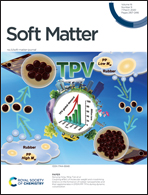Energy dissipation via the internal fracture of the silica particle network in inorganic/organic double network ion gels†
Abstract
Inorganic/organic double network (DN) ion gels, which are composed of an inorganic silica particle network, an organic poly(N,N-dimethylacrylamide) (PDMAAm) network, and a large amount of ionic liquid, showed excellent mechanical strength of over 25 MPa compression fracture stress at an 80 wt% ionic liquid content. The excellent mechanical strength of these inorganic/organic DN ion gels was attributed to the energy dissipation of the inorganic/organic DN structure. It has been considered that the energy dissipation in inorganic/organic DN ion gels is caused by the internal fracture of the silica particle network, which is preferentially fractured by deformation. However, no studies aiming to investigate the internal fracture of the silica particle network in inorganic/organic DN ion gels have been conducted by direct approaches. In this study, the internal fracture of the silica particle network in the inorganic/organic DN ion gel was directly evaluated by a small angle X-ray scattering (SAXS) technique. The synchrotron SAXS measurements conducted under a uniaxial loading–unloading process demonstrated that the aggregation size of the silica particle network irreversibly decreased with uniaxial stretch. Based on these results, it was clarified that the energy dissipation of the inorganic/organic DN ion gels was attributed to the internal fracture of the silica particle network.



 Please wait while we load your content...
Please wait while we load your content...